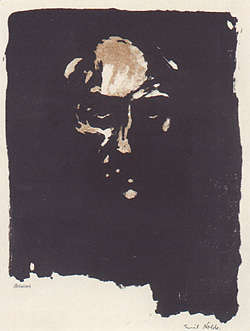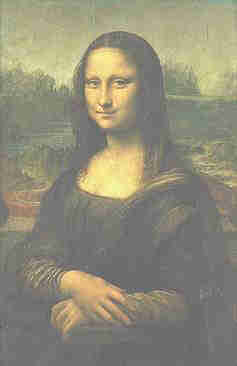 ^ Died on 15 April 1956:
Emil Hansen “Nolde”, German Expressionist
painter, watercolorist, and printmaker known for his violent religious works
and his foreboding landscapes. He dies in Seebüll, West Germany. He
was born on 07 August 1867.
^ Died on 15 April 1956:
Emil Hansen “Nolde”, German Expressionist
painter, watercolorist, and printmaker known for his violent religious works
and his foreboding landscapes. He dies in Seebüll, West Germany. He
was born on 07 August 1867.["Düsterer Männerkopf" (Selbstbildnis), Lithographie 1907 >]
— He was born Emil Hansen at Nolde near Tondern in northest Schleswig (now Tänder in southern Denmark) into a farming family, his father a Frisian-German, his mother Danish. The youthful Emil made his living as a woodcarver. He was able to study art formally only when some of his early works were reproduced and sold as postcards. Emil Hansen changed his name to Emil Nolde about 1904.
In Paris Nolde began to paint works that bear a superficial affinity to Impressionist painting. In 1906 he was invited to join Die Brücke, an association of Dresden-based Expressionist artists who admired his "storm of color." But Nolde, a solitary and intuitive painter, dissociated himself from that tightly knit group after a year and a half.
Nolde married Ada Vilstrup, who collaborated with him, printing many of the woodcuts, keeping records, etc.
Fervently religious and racked by a sense of sin, Nolde created such works as Dance Around the Golden Calf (1910) and In the Port of Alexandria from the series depicting The Legend of St. Maria Aegyptica (1912), in which the erotic frenzy of the figures and the demonic, masklike faces are rendered with deliberately crude draftsmanship and dissonant colors.
In the Doubting Thomas from the nine-part polyptych The Life of Christ (1911-1912), the relief of Nolde's own religious doubts may be seen in the quiet awe of Saint Thomas as he is confronted with Jesus' wounds. During 1913 and 1914 Nolde was a member of an ethnological expedition that reached the East Indies. There he was impressed with the power of unsophisticated belief, as is evident in his lithograph Dancer (1913).
Back in Europe, Nolde led an increasingly reclusive life on the Baltic coast of Germany. He lived at Seebüll¸close to the Danish border. His almost mystical affinity for the brooding terrain led to such works as his Marsh Landscape (1916), in which the low horizon, dominated by dark clouds, creates a majestic sense of space. Landscapes done after 1916 were generally of a cooler tonality than his early works. But his masterful realizations of flowers retain the brilliant colors. of his earlier works. He was a prolific graphic artist especially noted for the stark black and white effect that he employed in crudely incised woodcuts.
Although Nolde was an early advocate of Germany's National Socialist Party, after the Nazis came to power, they included his work in the “Entartete Kunst” (Degenerate Art) exhibition they mounted in 1937 in Munich. That put Nolde in the company of Jankel Adler [26 Jul 1895 – 25 Apr 1949], Ernst Barlach [02 Jan 1870 – 24 Oct 1938], Rudolf Bauer, Philipp Bauknecht, Otto Baum, Willi Baumeister [22 Jan 1889 – 31 Aug 1955], Herbert Bayer [05 Apr 1900 – 30 Sep 1985], Max Beckmann [12 Feb 1884 – 27 Dec 1950], Rudolf Belling [26 Aug 1886 – 09 Jun 1972], Paul Bindel, Theo Brün, Max Burchartz, Fritz Burger-Mühlfeld, Paul Camenisch, Karl Caspar, Maria Caspar-Filser, Pol Cassel, Marc Chagall [07 Jul 1887 – 28 Mar 1985], Lovis Corinth [21 Jul 1858 – 17 Jul 1925], Heinrich Davringhausen, Walter Dexel, Johannes Diesner, Otto Dix [02 Dec 1891 – 25 Jul 1969], Johannes Dreisch, Hans Christoph Drexel, Heinrich Eberhard, Max Ernst [02 Apr 1891 – 01 Apr 1976], Hans Feibusch, Lyonel Feininger, Conrad Felixmüller [21 May 1897 – 24 Mar 1977], Otto Freundlich [10 Jul 1878 – 09 Mar 1943 in Maidanek concentration camp], Xavier Fuhr, Ludwig Gies [03 Sep 1887 – 27 Jan 1966], Walter Gilles, Otto Gleichmann [20 Aug 1887 – 02 Nov 1963], Rudolph Grossmann, George Grosz [26 Jul 1893 – 06 Jul 1959], Hans Grunding, Richard Haizmann, Raoul Hausmann [12 Jul 1886 – 01 Feb 1971], Guido Hebert, Erich Heckel [31 Jul 1883 – 27 Jan 1970], Wilhelm Heckrott, Jacoba van Heemskerck [01 Apr 1876 – 03 Aug 1923], Hans Seibert von Heister, Oswald Herzog, Werner Heuser, Heinrich Hoerle, Karl Höfer [11 Oct 1878 – 03 Apr 1955], Eugen Hoffman, Johannes Itten [11 Nov 1888 – 25 May 1967], Alexei von Jawlensky, Eric Johansen, Hans Jürgen Kallmann, Wassily Kandinsky, Hans Katz, Ernst Ludwig Kirchner, Paul Klee, Cesar Klein, Paul Kleinschmidt, Oskar Kokoschka, Otto Lange, Wilhelm Lehmbruck, El Lissitzky, Oskar Lüthy, Franz Marc, Gerhard Marcks, Ewald Matare, Ludwig Meidner, Jean Metzinger, Constantin von Mitschke-Collande, Laszlo Moholy-Nagy, Margarethe Moll, Oskar Moll, Johannes Molzahn, Piet Mondrian, George Muche, Otto Mueller, Erich Nagel, Heinrich Nauen, Ernst Wilhelm Nay, Karel Neistrath, Otto Pankok, Max Pechstein, Max Peiffer-Watenphul [1896-1976], Hans Purrmann, Max Rauh, Hans Richter, Emy Röder, Christian Rohlfs, Edwin Scharff, Oskar Schlemmer, Rudolph Schlichter, Karl Schmidt-Rottluff, Werner Scholz, Lothar Schreyer, Otto Schubert, Kurt Schwitters, Lasar Segal, Friedrich Skade, Friedrich “Fritz” Stukenberg, Paul Thalheimer, Johannes Tietz, Arnold Topp, Karl Völker, Christoph Voll, William Wauer, and Gert Wollheim.
In 1941 the Nazi regime forbade Nolde to paint (but he secretly painted over 1300 small watercolors which he called “Ungemalten Bilder”). Most of his woodcuts, etchings, and lithographs were made between 1905 and 1937. After World War II he resumed painting but often merely reworked older themes. His last Self~Portrait (1947) retains his vigorous brushwork but reveals the disillusioned withdrawal of the artist in his 80th year.
There is a great richness and the unusual diversity in Nolde's work, oil-paintings, water-colors, drawings, graphic works, and arts and crafts, of landscapes and seas, portraits, flower gardens, grotesques and fantasies, with pictures of big city nightlife in Berlin and others from his trip to the South Seas.
“Art is exalted above religions and races. Not a single solitary soul these days believes in the religions of the Assyrians, the Egyptians, and the Greeks. And their races are exhausted, crossbred and spoiled. Only their art, whenever it was beautiful, stands proud and exalted, rising above all time.” — Emil Nolde, 1911
— Nolde (sein ursprünglicher Name war Hansen) zählt zu den führenden Malern des Expressionismus und gilt als einer der großen Aquarellisten in der Kunst des 20. Jahrhunderts, sein eigentliches Ausdruckmittel war die Farbe.
Noldes ehemaliger Wohnsitz Seebüll liegt an der Grenze zu Dänemark inmitten der weiten Marschlandschaft nahe der Nordsee auf einer hohen Warft, nicht weit von Tondern und dem Dorf Nolde, wo der Maler 1867 als Sohn eines Bauern geboren wurde.
Nolde ist weit und häufig gereist, die Winter verbrachte er zumeist in Berlin; doch empfand er zeitlebens eine tiefe Verbundenheit zu seiner Heimatlandschaft.
— LINKS
— E.N. (Selbstporträt) (1908 etching, 31x24cm; full size)
— Autumn Sea VII (1910; 644x750pix, 144kb _ ZOOM)
— Candle Dancers (1912; 1000x859, 276kb
— Child and Large Bird (632x750pix, 70kb _ ZOOM)
— Dance Around the Golden Calf (1910, 88x105cm _ ZOOM)
— Excited People (1913; 2500x1828pix, 1642kb _ ZOOM)
— Legend: Saint Mary of Egypt - Death in the Desert (1912; 836x960pix, 252kb _ ZOOM)
— Masks and Dahlias Still Life
— Mask Still Life III (1911, 74x78cm _ ZOOM)
— Wildly Dancing Children (1909; 622x750pix, 114kb _ ZOOM)
— Women and a Pierrot (1000x851pix, 106kb _ ZOOM)
— Christ (1000x783pix, 102kb) — Crucifixion (1912, 220x193cm; 750x661pix, 101kb _ ZOOM)
— Wildly Dancing Children (1909) — Amaryllis Madonna (750x524pix, 40kb)
— Sultry Evening (1930; 551x750pix, 70kb) — Masks and Dahlias
— Sunflowers (1936; 750x565pix, 87kb)
— Branch of Orchids (34x47cm; 2/5 size, 64kb _ ZOOM not recommended to 4/5 size, 215kb)
— Tänzerinnen (1917 woodcut, 24x30cm; full size, 245kb)
— Zwei Teufel (1906 etching, 20x15cm; full size, 91kb)
— Sibirische Gutsherren (1918 etching, 30x25cm; half~size, 80kb)
— Kniendes Mädchen (1907 etching, 30x22cm; half~size, 61kb)
— Klatsch (1905 etching, 18x13cm; full size, 83kb)
— Lichter Kopf (1917 woodcut, 31x24cm; 3/5 size, 84kb)
— Familie (1917 woodcut, 24x33cm; half~size, 99kb _ ZOOM not recommended to full size, 326kb)
— Der Graf (1918 etching, 31x23cm, 67kb _ ZOOM not recommended to full size, 237kb)
— Eva (1923 etching, 48x31cm; 2/5 size, 59kb _ ZOOM not recommended to 4/5 size, 229kb)
— Dampfer (1910 etching, 31x40cm; 2/5 size _ ZOOM not recommended to 4/5 size, 217kb) _ if it took more than 2 minutes to scribble, it was a waste of time. It may sound like “damp fur”, but it has nothing to do with it.
— Fischdampfer (1910, 30x40cm; 2/5 size, 64kb _ ZOOM not recommended to 4/5 size, 207kb) _ now it should be obvious that “fish damp fur” is not the correct translation. This picture is less hurriedly done; it may have taken as much as 10 minutes.
— Frauenkopf (36x28cm; 2/5 size, 48kb _ ZOOM not recommended to 4/5 size, 181kb)
— a different Frauenkopf (50x37cm; 1/3 size, 46kb _ ZOOM not recommended to 2/3 size, 168kb)
— Ältere Herren (1926, 16x11cm; 6/5 size, 90kb)
— Diskussion (1913, 76x58cm; 1/5 size, 62kb _ ZOOM not recommended to 2/5 size _ much less ZOOM++ to 4/5 size)
